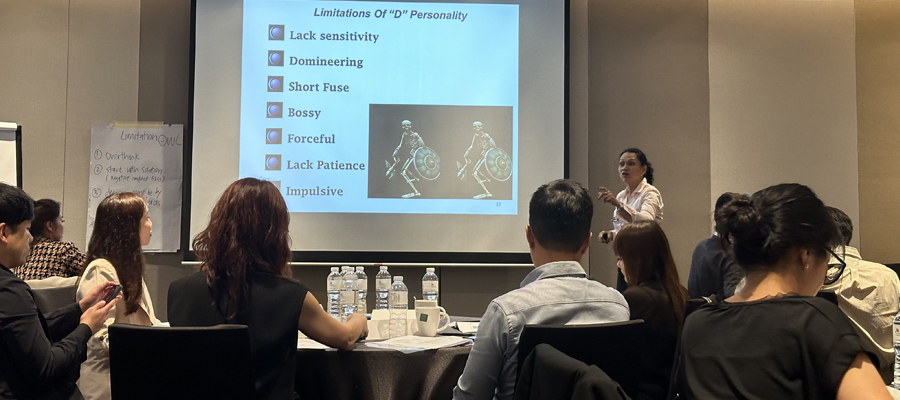
DISC Profiling
We are in the business of building relationships! People are not necessarily difficult to deal with. They only seem difficult because we lack the skills of an appropriate communication style. It is imperative that we are equipped with the essential skills to handle different groups of people.
OBJECTIVES
- Improve participants’ performance levels.
- Reduce stress levels among colleagues.
- Confidently handle and lessen grievances and complaints in a systematic and calm fashion.
- Master the art of objection handling and work towards a resolution.
OUTLINE
Understanding of the 4 DISC Behavioural Styles of Dominance, Influence, Steady, Compliant
- DISC profile reports to be distributed to participants. (Participants would have completed online assessment prior to workshop) (Hardcopy Report).
- OR assessment to be carried in class (Hardcopy Questionnaire).
- *Introduction and background to the DISC profile.
THE DISC® INSTRUMENT
DISC is the four quadrant behavioral model based on the work of William Moulton Marston PhD (1893–1947) to examine the behaviour of individuals in their environment or within a specific situation (otherwise known as environment). It therefore focuses on the styles and preferences of such behavior.
This system of dimensions of observable behavior has become known as the universal language of behavior. All individuals possess all four, but what differs from one to another is the extent of each. For most, these types are seen in shades of grey rather than black or white, and within that, there is an interplay of behaviors, otherwise known as blends. The denotation of such blends starts with the primary (or stronger) type, followed by the secondary (or lesser) type, although all contribute more than just purely the strength of that "signal".
Having understood the differences between these blends makes it possible to integrate individual team members with less troubleshooting. In a typical team, there are varying degrees of compatibility, not just toward tasks but interpersonal relationships as well. However, when they are identified, energy can be spent on refining the results.
Each of these types has its own unique value to the team, ideal environment, general characteristics, what the individual is motivated by, and value to team.
Identify Individual Participants’ DISC profile.
- Participants to be divided into respective DISC groups.
- Each group to discuss and share strengths and weaknesses to the class.
Understand the Style & Motivation of People’s Communication
- Learning to improve work effectiveness for each personality type.
- Understand the motivation of each profile type due to personality and communication preferences.
- Guess each other’s profile by getting each participant to understand how the class perceives his/her personality at the workplace.
- Understand the dominant motivational factors and stressors of each DISC type.
Identify Ways to Relate to Others
Learn to customize communication style to each DISC profile type.
Review and Conclusion
DURATION
One Day
How to Work More Effectively with others using the MBTI
We are in the business of building relationships! People are not necessarily difficult to deal with. You will learn the appropriate communication styles that will help avoid ineffective communication and improve work relationships in teams. Learn the importance of people motivation through the MBTI.
OBJECTIVES
- How to know each other better to work as team.
- Key elements of what makes an effective team.
- What drives us, our passion, interests, what excites us.
- Improved understanding of the way in which the team members behave.
- Understanding Personality Type ‐ Understanding the Personality Type of the Team (16 different personality types).
- Learn to value and capitalize on the differing Types among colleagues.
- How can we work together more effectively.
- Why EQ matters in leadership and management.
OUTLINE
Understanding People Communication Tendencies
- Using the *MBTI (Myers Briggs Type Indicator) to understand an individual’s outward behaviour and thought processes.
- Understanding psychological preferences.
- Using the MBTI for team work, decision making, information processing, relationship building and coping with change and uncertainty.
- Practical applications of MBTI at the workplace in terms of dealing with change and employees’ learning styles—Pragmatist, socialiser, symbolist and conceptualiser.
- Identifying how the MBTI can be used as a tool to motivate and influence people.
*THE MBTI® INSTRUMENT
MBTI® instrument. The MBTI is the most widely used personality instrument in the world, with more than two million people taking it annually. It is a forced choice, self-report, personality questionnaire used to measure and describe people’s preferences for how they like to get information, make decisions and orient their lives. It is based on Carl Jung’s theory of perception and judgment and classifies people into 16 broad personality Types.
The MBTI provides a simple way of seeing how people are alike and how they differ. When people are aware of their differences, they can build better understanding and reduce conflict. The MBTI thus helps to improve teamwork and productivity whilst reducing unproductive interpersonal and intra organizational conflict. Individuals can use their MBTI results to understand their preferred learning styles, evaluate the fit between themselves and their jobs and better manage time and stress. It is also very effective for profiling teams and developing team effectiveness.
DURATION
One Day
